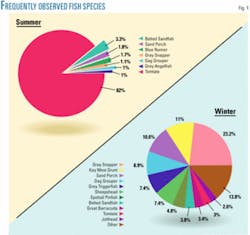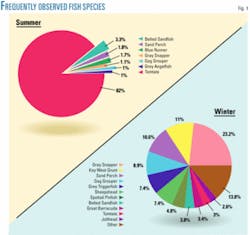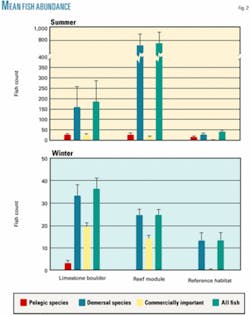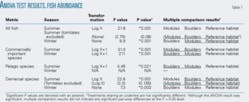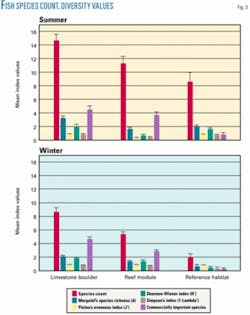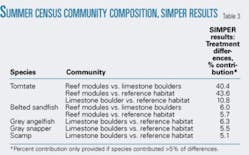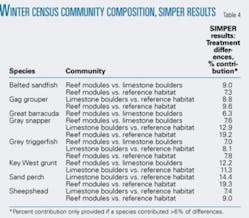Habitat replacement areas used by Gulfstream Natural Gas System LLC on the Gulf of Mexico seafloor have provided habitat for both the recruitment of sessile epifauna-epifora and use by a substantial demersal and commercially important fish community. Biotic cover has moved to these areas in a greater diversity and abundance than found in neighboring undisturbed areas. A greater diversity of fish also exists in the habitat replacement areas.
Part 3 of this series (OGJ, Jan. 15, 2007, p. 60) evaluated the success of the habitat replacement sites in terms of both colonization by sessile epifauna, and habitat use by reef fishes. The article’s conclusion, presented here, offers a detailed examination of the project’s postconstruction fish community and a discussion of the habitat replacement program’s effects on this community.
Fish community
Abiotic conditions observed during fish census activities show that the stations were similar and sampled under comparable conditions. Mean water temperature during the winter census was cooler on the bottom (21.9° C.) than that found during the summer census (26.9° C.). Regardless of the time of year, however, bottom temperature was similar across all stations.
The fish census methodology required divers to survey a 5-m radius visually from a position above each point count station. Secchi measurements at all stations ranged from 6.9 to 15.9 m during the summer survey and 6.4 to 13.3 m during the winter survey, showing that water clarity was sufficient for conducting fish census activities at all sampling stations.
Surveyors recorded 56 different fish species during the summer census, compared to only 25 during the winter census. Of the species recorded, 12 have commercial importance:
- Black Grouper.
- Gag Grouper.
- Goliath Grouper.
- Gray Snapper.
- Greater Amberjack.
- Gray Triggerfish.
- Hogfish.
- Lane Snapper.
- Red Grouper.
- Scamp.
- Spanish Mackerel.
- Yellowtail Snapper.
The majority of the species recorded during both seasons were demersal species, having direct ties to the bottom substrate. Fig. 1 shows the dominant species for each season.
Tomtates represented more than 82% of recordings in the summer census. Juvenile schools, however, were most often encountered and census takers therefore could not make exact counts of this species. Using the Bohnsack method instead provided estimated counts for these schools. Separate parallel analyses excluded tomtates in order to avoid skewed results stemming from their dominance.
Gray snapper dominated during the winter census, representing almost 25% of observed individuals. The Key West grunt and sand perch both represented more than 10% of the population as the second and third most commonly observed species, respectively.
Mean abundance of all fish species, commercially important species, and demersal species was higher at habitat replacement stations than at reference habitat stations, regardless of season (Fig. 2).
Replacement stations’ higher vertical relief may partially explain this. Relief in the reference habitat generally did not exceed 0.5 m, while the reef modules were all 1 m high and relief ranged from 0.75-1.5 m in the limestone boulder sites.
Surface roughness is also an important habitat feature and the rugosity measurements taken during fish sampling showed greater habitat complexity in the habitat replacement areas. The limestone boulder stations had the highest mean rugosity value (1.55) followed by the reef module stations (1.16). The reference habitat stations had the lowest value (1.05).
Fish abundance was significantly greater at reef module stations than at limestone boulder stations during summer when tomtates were included. This pattern, however, switched in the winter, when fish abundance was significantly higher at the limestone boulder stations (Table 1).
The recorded number of fish species, number of commercially important species, number of demersal species, and number of pelagic species were all greater at the habitat replacement stations than at the reference habitat stations. Diversity indices calculated for both seasons likewise show the habitat replacement stations as more diverse than the reference habitat stations. Between the two habitat replacement types, diversity was greater at the limestone boulder sites (Fig. 3).
PRIMER analysis shows that fish community structure differs between the habitat replacement and reference habitat stations (Table 2). This is not surprising given the greater diversity of species observed at the habitat replacement stations.
SIMPER results for the summer show that the tomtate and belted sandfish, both with a greater presence on the reef modules, contributed substantially to community structure differences (Table 3). The presence of gray angelfish, gray snapper, and scamps at the limestone boulder stations also contributed to a community different from the reference habitat stations (Table 3).
SIMPER results for the winter show that the increased presence of gag groupers, gray triggerfish, mangrove snapper, sand perch, and sheepshead at the habitat replacement stations contributed substantially to community structure differences from the reference habitat (Table 4). Belted sandfish, great barracuda, and Key West grunt contributed to differences between the habitat-replacement types (Table 4) with the gray triggerfish, great barracuda, Key West grunt, and mangrove snapper all more abundant at the limestone boulder sites.
The community structure of commercially important species was also different between the habitat replacement and reference stations (Table 2). The relatively low number of commercially important species found in the reference habitat mitigated against performing SIMPER results on this segment of the population. Community differences between the reef module and limestone boulder stations for commercially important species existed only in the winter (Table 2).
Results
The specific gravity and size of limestone used to create the replacement habitat proved to be sufficient, as neither feature-type is displaying signs of movement or dissolution since initial placement. Habitat replacement areas provide hard-bottom structure in areas that would otherwise be bare sand. They also have a greater amount of relief and habitat complexity than neighboring natural live hard-bottom. The surfaces of the habitat replacement sites support epifaunal-epifloral colonization and have substantially higher levels of biotic cover than the hard-bottom reference areas.
A difference exists in the epifaunal-epifloral community structure of the habitat replacement as compared to natural-hard-bottom areas; the diversity and abundance of organisms within the habitat replacement areas are greater. Increased algal cover, including coralline, macro, and turf algal species caused a large proportion of this difference. A broader array of species, rather than an entirely different group of organisms, colonized the habitat replacement sites.
The increased vertical relief and surface area of the replacement habitat may have contributed to recruitment success through increased exposure to spores and larvae within the water column, with successful establishment of lasting communities helped by reduced sediment abrasion.
Fish abundance was more than twice as great in the summer census, with more than twice as many species also recorded. Demersal species were dominant during both census periods, with many commercially important species also present in both periods. Regardless of season, a relatively diverse fish community uses the habitat replacement areas and both methods of habitat replacement, limestone boulders and reef modules, have a greater abundance and number of species on them than natural hard-live bottom areas in the same area.
Commercially important species are also more abundant and diverse on both types of habitat replacement structures than in natural hard-bottom areas. Numerous grouper species (particularly red grouper) use the habitat-replacement areas, significant because the Gulf of Mexico Fisheries Management Council (GOMFMC) is trying to close commercial grouper fishing within federal waters Feb. 15-Mar. 15.
The time frame corresponds to a peak in the grouper spawning period. Both the GOMFMC and state of Florida (Florida Fish and Wildlife Conservation Commission) also have voted to reduce red grouper bag limits in response to information from the National Marine Fisheries Service that the current grouper population is being severely overfished.
Similar to the epifaunal-epifloral community, habitat replacement areas are being used by a wider range of fish species than natural hard-live bottom, not simply a different group of fish. A seasonal shift in rank abundance between the two habitat-replacement sites makes it difficult to determine which of the two, limestone boulder or reef module, is a more successful mitigation technique.
Demersal fish species used both habitats in relatively high abundance, showing the potential importance of using both types of mitigation habitat.
The reduction in both species abundance and diversity between the summer and winter census may not reflect a regular seasonal cycle but the influence of a red tide event.
Red tide is a natural marine algal disturbance that can damage benthos and fish populations. The dinoflagellate responsible for the red tide blooms, Karenia brevis, has resided on the west Florida continental shelf since 1844. The microalgal cells produce a toxin that kills fish, mobile invertebrates, and sessile epifauna. Red tide also depletes dissolved oxygen (DO) levels, creating hypoxic conditions (DO <2-3 mg/l.) in the water column.
The summer 2005 red tide affected Tampa Bay and the northeast-central Gulf of Mexico. Collection of summer fish census and photostation information happened before the red tide while the winter fish census and transect information was collected after the red tide and during the initial recovery phases.
The red tide radically changed the benthic community structure. The toxins and hypoxia it created resulted in mass mortalities to virtually all benthic invertebrates: anemones, zooanthids, octocorals, firecorals, stony corals, polychaetes, mollusks, crustaceans, and echinoderms. All hard bottom areas, including the habitat replacement sites, became barren.
The ability of fish to temporarily move into deeper water and recolonize shallower depths when favorable conditions return limited the red tides’ damage to them relative to the invertebrate population.
The timing of the red tide provides an opportunity to compare recovery of the benthic and fish communities, in terms of both recovery rate and species composition, in the mitigation areas as compared to natural hard-live bottom. Gulfstream expects that the mitigation areas may recover more quickly, their greater surface complexity and vertical relief possibly improving recruitment rates.
